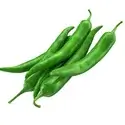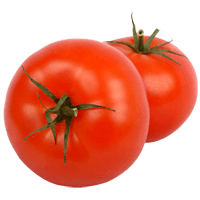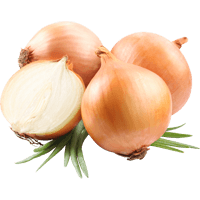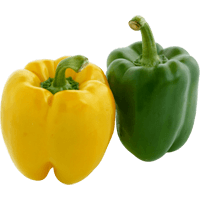Chili Pepper nutrition: calories, carbs, GI, protein, fiber, fats
Peppers, hot chili, green, raw
*all the values are displayed for the amount of 100 grams
Top nutrition facts for Chili Pepper

| Calories ⓘ Calories for selected serving | 40 kcal |
| Glycemic index ⓘ Gi values are taken from various scientific sources. GI values less than 55 are considered as low. Values above 70 are considered as high. | 10 (low) |
| Net Carbs ⓘ Net Carbs = Total Carbohydrates – Fiber – Sugar Alcohols | 8 grams |
| Default serving size ⓘ Serving sizes are mostly taken from FDA's Reference Amounts Customarily Consumed (RACCs) | 1 pepper (45 grams) |
| Acidity (Based on PRAL) ⓘ PRAL (Potential renal acid load) is calculated using a formula. On the PRAL scale the higher the positive value, the more is the acidifying effect on the body. The lower the negative value, the higher the alkalinity of the food. 0 is neutral. | -5.3 (alkaline) |
| Oxalates ⓘ https://www.researchgate.net/publication/280642641 | 10 mg |
Chili Pepper calories (kcal)
| Calories for different serving sizes of chili Pepper | Calories | Weight |
|---|---|---|
| Calories in 100 grams | 40 | |
| Calories in 1 pepper | 18 | 45 g |
| Calories in 0.5 cup, chopped or diced | 30 | 75 g |
| Calories for different varieties of chili Pepper | Calories | Weight |
|---|---|---|
| Peppers, hot chili, green, raw (this food) | 40 | 100 g |
| Peppers, hot chili, green, canned, pods, excluding seeds, solids and liquids | 21 | 100 g |
| Peppers, hot chili, red, canned, excluding seeds, solids and liquids | 21 | 100 g |
| Peppers, hot pickled, canned | 22 | 100 g |
| Peppers, hungarian, raw | 29 | 100 g |
| Peppers, hot chile, sun-dried | 324 | 100 g |
Extra Nutrition facts for Chili Pepper
| Protein per 100 calories ⓘ Shows how many grams of protein you get from 100 calories of this food, calculated as (protein in g ÷ calories) × 100. | 5 g |
| Calories per 10 g protein ⓘ Shows how many calories you need to eat from this food to get 10 g of protein, calculated as (calories ÷ protein in g) × 10. | 200 kcal |
Chili Pepper Glycemic index (GI)
Gi values are taken from various scientific sources. GI values less than 55 are considered as low. Values above 70 are considered as high.
Mineral coverage chart
Mineral chart - relative view
Vitamin coverage chart
Vitamin A:
177µg of 900µg
20%
Vitamin E:
2.1mg of 15mg
14%
Vitamin D:
0µg of 20µg
0%
Vitamin C:
728mg of 90mg
808%
Vitamin B1:
0.27mg of 1mg
23%
Vitamin B2:
0.27mg of 1mg
21%
Vitamin B3:
2.9mg of 16mg
18%
Vitamin B5:
0.18mg of 5mg
3.7%
Vitamin B6:
0.83mg of 1mg
64%
Folate:
69µg of 400µg
17%
Vitamin B12:
0µg of 2µg
0%
Vitamin K:
43µg of 120µg
36%
Vitamin chart - relative view
Macronutrients chart
Protein:
Daily Value: 4%
2 g of 50 g
2 g (4% of DV )
Fats:
Daily Value: 0%
0.2 g of 65 g
0.2 g (0% of DV )
Carbs:
Daily Value: 3%
9.5 g of 300 g
9.5 g (3% of DV )
Water:
Daily Value: 4%
87.7 g of 2,000 g
87.7 g (4% of DV )
Other:
0.6 g
0.6 g
Protein quality breakdown
Tryptophan:
78mg of 280mg
28%
Threonine:
222mg of 1,050mg
21%
Isoleucine:
195mg of 1,400mg
14%
Leucine:
315mg of 2,730mg
12%
Lysine:
267mg of 2,100mg
13%
Methionine:
72mg of 1,050mg
6.9%
Phenylalanine:
186mg of 1,750mg
11%
Valine:
252mg of 1,820mg
14%
Histidine:
123mg of 700mg
18%
Fat type information
Saturated fat:
0.02 g
Monounsaturated fat:
0.01 g
Polyunsaturated fat:
0.11 g
Fiber content ratio for Chili Pepper
Sugar:
5.1 g
Fiber:
1.5 g
Other:
2.9 g
All nutrients for Chili Pepper per 100g
| Nutrient | Value | DV% | In TOP % of foods | Comparison |
| Vitamin A | 59µg | 7% | 32% | |
| Calories | 40kcal | 2% | 91% |
1.2 times less than Orange
|
| Protein per 100 calories | 5g | N/A | 45% | |
| Protein | 2g | 5% | 78% |
1.4 times less than Broccoli
|
| Calories per 10 g protein | 200kcal | N/A | 49% | |
| Fats | 0.2g | 0% | 88% |
166.6 times less than Cheese
|
| Vitamin C | 243mg | 269% | 9% |
4.6 times more than Lemon
|
| Net carbs | 8g | N/A | 50% |
6.8 times less than Chocolate
|
| Carbs | 9.5g | 3% | 50% |
3 times less than Rice
|
| Cholesterol | 0mg | 0% | 100% |
N/A
|
| Vitamin D | 0µg | 0% | 100% |
N/A
|
| Magnesium | 25mg | 6% | 43% |
5.6 times less than Almonds
|
| Calcium | 18mg | 2% | 57% |
6.9 times less than Milk
|
| Potassium | 340mg | 10% | 28% |
2.3 times more than Cucumber
|
| Iron | 1.2mg | 15% | 54% |
2.2 times less than Beef broiled
|
| Sugar | 5.1g | N/A | 47% |
1.8 times less than Coca-Cola
|
| Fiber | 1.5g | 6% | 43% |
1.6 times less than Orange
|
| Copper | 0.17mg | 19% | 34% |
1.2 times more than Shiitake
|
| Zinc | 0.3mg | 3% | 80% |
21 times less than Beef broiled
|
| Phosphorus | 46mg | 7% | 78% |
4 times less than Chicken meat
|
| Sodium | 7mg | 0% | 87% |
70 times less than White bread
|
| Vitamin E | 0.69mg | 5% | 52% |
2.1 times less than Kiwi
|
| Manganese | 0.24mg | 10% | 49% | |
| Selenium | 0.5µg | 1% | 89% | |
| Vitamin B1 | 0.09mg | 8% | 52% |
3 times less than Pea raw
|
| Vitamin B2 | 0.09mg | 7% | 71% |
1.4 times less than Avocado
|
| Vitamin B3 | 0.95mg | 6% | 69% |
10.1 times less than Turkey meat
|
| Vitamin B5 | 0.06mg | 1% | 92% |
18.5 times less than Sunflower seeds
|
| Vitamin B6 | 0.28mg | 21% | 42% |
2.3 times more than Oats
|
| Vitamin B12 | 0µg | 0% | 100% |
N/A
|
| Vitamin K | 14µg | 12% | 48% |
7.1 times less than Broccoli
|
| Trans fat | 0g | N/A | 100% |
N/A
|
| Folate | 23µg | 6% | 46% |
2.7 times less than Brussels sprouts
|
| Saturated fat | 0.02g | 0% | 91% |
280.7 times less than Beef broiled
|
| Choline | 11mg | 2% | 84% | |
| Monounsaturated fat | 0.01g | N/A | 92% |
890.8 times less than Avocado
|
| Polyunsaturated fat | 0.11g | N/A | 84% |
432.8 times less than Walnut
|
| Tryptophan | 0.03mg | 0% | 91% |
11.7 times less than Chicken meat
|
| Threonine | 0.07mg | 0% | 92% |
9.7 times less than Beef broiled
|
| Isoleucine | 0.07mg | 0% | 93% |
14.1 times less than Salmon raw
|
| Leucine | 0.11mg | 0% | 93% |
23.2 times less than Tuna Bluefin
|
| Lysine | 0.09mg | 0% | 92% |
5.1 times less than Tofu
|
| Methionine | 0.02mg | 0% | 92% |
4 times less than Quinoa
|
| Phenylalanine | 0.06mg | 0% | 93% |
10.8 times less than Egg
|
| Valine | 0.08mg | 0% | 92% |
24.2 times less than Soybean raw
|
| Histidine | 0.04mg | 0% | 92% |
18.3 times less than Turkey meat
|
| Caffeine | 0mg | 0% | 100% | |
| Omega-3 - EPA | 0g | N/A | 100% |
N/A
|
| Omega-3 - DHA | 0g | N/A | 100% |
N/A
|
| Omega-3 - DPA | 0g | N/A | 100% |
N/A
|
Check out similar food or compare with current
NUTRITION FACTS LABEL
Nutrition Facts
___servings per container
Serving Size ______________
Serving Size ______________
Amount Per 100g
Calories 40
% Daily Value*
0.31%
Total Fat
0.2g
0.1%
Saturated Fat 0.02g
0
Trans Fat
0g
0
Cholesterol 0mg
0.3%
Sodium 7mg
3.2%
Total Carbohydrate
9.5g
6%
Dietary Fiber
1.5g
Total Sugars 0g
Includes ? g Added Sugars
Protein
2g
Vitamin D
0mcg
0
Calcium
18mg
1.8%
Iron
1.2mg
15%
Potassium
340mg
10%
*
The % Daily Value (DV) tells you how much a nutrient in a serving of food contributes to a daily diet. 2,000 calories a day is used for general nutrition advice.
Health checks
ⓘ
Dietary cholesterol is not associated with an increased risk of coronary heart disease in healthy individuals. However, dietary cholesterol is common in foods that are high in harmful saturated fats.
Source
Low in Cholesterol
ⓘ
Trans fat consumption increases the risk of cardiovascular disease and mortality by negatively affecting blood lipid levels.
Source
No Trans Fats
ⓘ
Saturated fat intake can raise total cholesterol and LDL (low-density lipoprotein) levels, leading to an increased risk of atherosclerosis. Dietary guidelines recommend limiting saturated fats to under 10% of calories a day.
Source
Low in Saturated Fats
ⓘ
While the consumption of moderate amounts of added sugars is not detrimental to health, an excessive intake can increase the risk of obesity, and therefore, diabetes.
Source
Low in Sugars
Chili Pepper nutrition infographic

Infographic link
References
All the values for which the sources are not specified explicitly are taken from FDA’s Food Central. The exact link to the food presented on this page can be found below.


